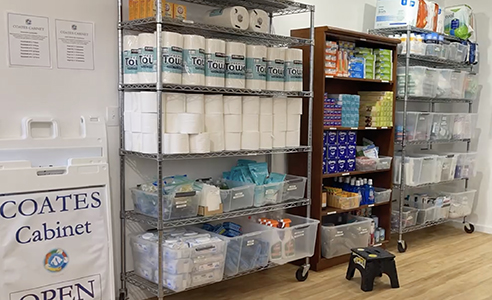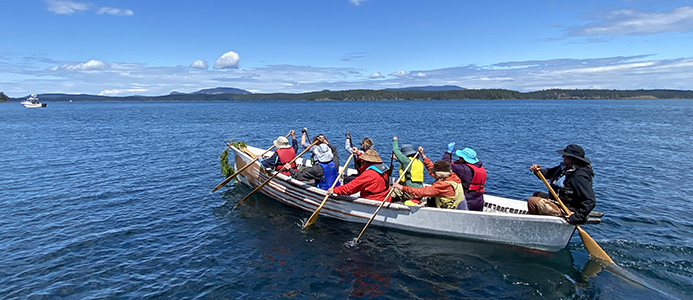||| FROM ALEX MCLEOD |||
In the early 2000s, I was the chair of the San Juan County Ferry Advisory Committee. This was shortly after the Legislature had killed the motor-vehicle excise tax, a major source of funding for ferries. As a result, fares more than doubled almost overnight and service declined, mostly because of the age of many ferries.
It was clear Washington State Ferries (WSF) headquarters had little interest in service to the San Juans because of its remoteness and lack of political heft in Olympia, but there were some very knowledgeable, helpful people in front-line operations jobs we worked with to make the best of what we had.
During that time, a well-intentioned WSF boss suddenly retired the so-called “steel-electric” class of ferries, old and relatively small but key to service between Whidbey Island and Port Townsend. The plan was to replace them with much bigger boats that could serve other routes as well.
However, elected officials in Port Townsend and Jefferson County banded together to oppose the plan, which would have flooded downtown Port Townsend with hundreds of cars every hour. Their opposition killed that plan. (WSF’s solution to was to build smaller boats based on a Martha’s Vineyard route, but the WSF version unfortunately didn’t sit evenly in the water and were quickly dubbed the I Lean Class.)
Seeing how one small county and town, when it spoke out, could get WSF’s attention, I pressed San Juan County to begin doing the same. While the need for new boats was obvious, one of WSF’s plans was to build a new terminal in Anacortes at a cost of about $165 million. It made no sense (and almost 20 years later still hasn’t been done).
WSF didn’t appreciate the aggressiveness of our committee and captured the ears of several council members, who “fired” me from my voluntary position and sat back waiting for things to get better. That hasn’t worked out all that well.
Now, a different group of council members have been sitting silently as ferry service to the county — our version of state highways — has crumbled. Fewer than half of the county’s sailings have been on time. More than 300 sailings this summer were cancelled, more than three times the number of the summer before and about seven times the summer of 2020, when service and travel were reduced due to the pandemic.
Cancelled sailings are particularly problematic in San Juan County, especially when it involves the ferry that takes students, workers and people with doctor’s appointments from one island to another. This is a ferry built when Eisenhower was president and Fidel Castro had taken over in Cuba. Its mechanical reliability is about what you’d expect.
It is not uncommon for someone to have gone, say, to Lopez only to discover the inter-island boat has gone out-of-service (OOS in WSF parlance); then standing and watching as a mainline ferry from Anacortes, headed where you want to go, just sails on by, leaving you to wait a couple of hours to catch a mainline boat to Anacortes, then wait to catch a different mainline boat that will stop where you live. A 10-minute trip turns into nine hours.
Now that school is in session and the weather is turning toward winter, there is every expectation the problems will grow worse. While there are no long-term solutions in sight, there are immediate things that could be done to protect against the worst.
One would be to have WSF swap a more reliable boat for the inter-island boat. That would put the less reliable boat much closer to WSF’s repair facilities and give the county hope that inter-island service could be stabilized.
Another would be to have WSF set up an alert system that would immediately shift all the mainline boats to stop at all islands each way between Anacortes and Friday Harbor. WSF does it now ad hoc and through layers of bureaucracy and very slowly. They need to have a plan and give authority to implement it to one person who hopefully knows the islands’ needs. It’s hardly a perfect solution because it would undoubtedly lead to unhappy mainline travelers, especially at the Anacortes end. But it wouldn’t leave inter-island travelers — especially school kids — stranded away from their homes.
Doing either of these options has drawbacks. Doing neither guarantees what we know is bad will almost inevitably get worse. It’s up to the county council to decide. Unless it speaks up, the worst is what we’ll get.
ORIGINALLY PUBLISHED ON SALISH CURRENT









Alex, interesting information.. it’s clear that no plan is still a plan…. The Bar has been lowered to less then 40/60 percent expectations of service. How this is acceptable in any category is beyond comprehension. Imagine those odds in any forum.. Health/Wellness, Finance, or any other Public Service.
Our WSF is transportation to and from these institutions.. with little back up other than Air or Private Vessel.
Will this be the New/New platform for political votes for Candidates.. I CARE.. A NEW DEAL??
As I read this, I’m sitting in the upper parking lot at Orcas Landing, having been bumped from my (reserved) slot on the Chelan and promised that I’ll get a place on the next ferry, which is probably the Chelan again at 5:15 or later. Almost certainly later, as the Chelan just left here nearly 10 minutes late.
The core problem is that the Yakima is out of service today and all its reserved vehicles are getting bumped onto whatever else may be available, which means the smaller Chelan. There are now at least 50 of us sitting in our hot cars in the upper parking lot, waiting impatiently for the WSF guy to come up here and tell us to come down into the (hopefully vacant) ferry lanes, as he claimed he would about half an hour ago. We’ll see.
Stay tuned for updates on this colossal mess.
What an effing mess! The WSF guys (that’s a mild term) forgot to send someone up the hill to tell us to come down and began loading up the ferry lines with vehicles that arrived much later — AFTER the Chelan had sailed and emptied the lines! I finally figured out the screw up and began leading a procession of patient ferry customers down the hill to claim our rightful places in line. But by the time we got in line, four lanes had already been filled and only three were left. So some of the patient folks still up there are going to get doubly screwed and probably have to wait until well after dark, since the Chelan can hold only about 135 vehicles.
A group of Orcas visitors among them told me they’re never coming back.
Finally made it on the 5:15 pm Chelan, which left Orcas Landing over a half hour late. But most of the poor, patient islanders (and a few tourists that I talked with) from up on the hill did not make it and will have to wait for the next ferry, scheduled at 8:50 pm, which will probably leave an hour later, given how bad things are going. . . .
Maybe the state needs to use some of its surplus funds and BUY a used ferry from BC Ferries. Or somewhere else in the world. There must be one on the market. We can’t wait years for a new one to be built!
I feel your pain. I had a reservation for the 7:25 p.m. ferry last night. But they announced that the Yakima was out of service just before she was scheduled to sail. So, I walked on the Samish at 8:20 p.m., which was making an unscheduled stop at Orcas just to ensure I got home. This is not the first time I’ve parked my car and walked on. Islanders do what we must do to ensure we can travel back and forth to the mainland for appointments.
The tourists have other options. They can vacation someplace else.
Perhaps, just for grins, WADOT could contact the B.C. Ferry Authority to determine which ferries the authority is planning to replace in 2024 or 2025.
If they have suitable surplus vessel(s) that are newer than the vessels in our current fleet, perhaps it would be in the state’s best interest to consider purchasing one or more ferries from our Canadian neighbors. Or, if money is tight, (never mind that we have a surplus in the state budget) perhaps we could negotiate a short- term lease for one or more seaworthy vessels from the B.C. Ferry Authority. Let’s say, five to ten years?
Adding new vessels to the fleet could provide some badly needed relief while our state takes a decade to build a new fleet. Hopefully, the ferry caucus in Olympia is open to considering viable, short-term solutions that could preserve the integrity of the fleet – not to mention our sanity.
I recently met with an older gentleman who grew up here and has a significant business.
I asked him what was wrong with this Island.
He said; “We (the working people and residents) don’t own it anymore.
It’s owned by Friday Harbor”.
It is clear that the county doesn’t care at all about working people anymore. The county cares about tourism and short-term rentals.
Good luck getting someone to mow your lawn, paint your house, or pump the septic.
They can not afford to live here. There is no housing.
This also relates to travel.
It is time to adjust the legal issues around state travel and make it so if people can show proof of residency in San Juan County they should get priority loading on the ferry system.
Attn: Congressman Rick Larsen
The suggestions Alex McLeod made in his article would be a good starting point to solve inter-island ferry cancellations for residents and it can be done now.
It’s unacceptable to find out that your ferry is canceled 10 minutes before sailing and then have to wait 4 or 5 hours for the next one.
I have been saying the same thing John for over 20 years. Residents should get priority from the tourists. Residents have no choice but to deal with this broken system any time we need to go off island. Tourists can chose to visit somewhere else. It is time we got some respect from this system. The poor management of over 20 years is now showing itself and we are literally paying for it. If I miss a dental appointment because this ferry system is not working and I get charged for the missed appointment, I plan to sent the bill to WSF and will wait until hell freezes over to get it paid. I feel sorry for the ferry workers who are pawns in this game. We need to take back the system somehow so it serves us properly. Not sure how but I bet if Bea Ranker were alive she would have an idea.
I do not think our present Commissioners think we have a problem that needs their attention. When Hughes was the Commissioner, we heard when he went to Olympia to work in our behalf. I have not heard of a present commissioner going to the capital. Hughes replacement seemed to have one goal (short term housing). Until the folks that represent us, make constant trips to Olympia, and keep our Ferry Problems in the minds of the folks that spend the money, or run the WSF system. We will continue to be ignored. We have said for years that it is too bad we cannot close highway 5 down occasionally, so the folks in Olympia are unable to go home for hours/days at a time.
I have started my final year at Spring Street International School in Friday Harbor this September. For my senior project, I am working with WSDT to try to make the ferry system more reliable for the boatie kids at least for this winter. Last winter, many of us got stranded in Friday Harbor after school because of canceled or late ferries and had to wait outside while shops or stay the night on teacher’s couches. When the weather is good, parents can bring across private vessels to get us, but with the winter weather, that’s just not possible.
Mr. McLeod, your suggestions make sense and are similar to my own. I would like to work with you, or have a conversation with you about this, if you would be willing. Please email me if you are.
*while shops closed
my email is avandongen1708@gmail.com
Change takes place only if you are willing to fight for it! Often I hear in the SJIS, and nationally, ‘what can I do, I am only one person.’ I have a suggestion – get off your butt and employ collective action – Rally on Orcas, Rally on SJI, Rally on Lopez, Rally on Shaw. You might be surprised at the impact of a group of sign holding citizens splashed on the front page of the Seattle Times.
I have a critical medical appointment off island early Tuesday morning. As with all our scheduled critical activities now days (Costco runs don’t count!) we spend the prior night at a mainland motel . Not complaining, as with a lot of thigs, just a fact of island life.
Leading up to a ferry ride I check the ferry alerts the day before and the morning of the ride. Today I noted that the Samish was pulled out of service because of lack of crew and all the afternoon schedules were deleted and a new schedule was in place….”reservations priority, first come first served”. While on the website I noticed a box “We’re Hiring” in the lower right of the home page. I opened that page and I must be missing something because the only job opening listed is for a “Vessel Construction/Electrification Program Manager”. Is this correct that there are no job openings for officers, crew and terminal workers or are those listed somewhere else?
WSF has 21 ferries. Two are presently out of service for repairs .. one a long lead time gear issue, another to repair crash damage. They are operating 15 on their current schedule. So there are 19 available ferries (not sure if one is currently in overhaul) … so the problem isn’t lack of available ferries.
WSF fleet is probably as “new” as it has been since they acquired the system in 1951. Seven new ferries have been delivered since 2010. Virtually all of the older ferries have had major rebuilds since they were constructed, including the Tillicum, although that was done in 1994, so that is getting quite dated. Rebuilding it again probably doesn’t make sense.
As being part of the State Highway system, they cannot limit passage to just San Juan residents. That has been discussed for years, and the answer hasn’t and won’t change.
The solution is to have reliable boats, sufficient crews living near the overnight berthing terminals, and realistic schedules that provide realistic times to unload and load.
WSF has almost certainly the worst public transit performance of any public transportation system in the United States. The San Juan Island routes ARE getting first priority … that is appreciated, but that isn’t solving the multiple issues of just having a reliable transportation system. Dealing with 12 unions and 14 labor contracts is one of the big issues … but seniority staffing limitations and existing crew call in procedures makes crew manning a nightmare for the dispatchers who try to get crews on time and in place when required. Adding one extra crew member above Coast Guard minimum requirement to each vessel might be a logical start.
i agree that our ferry system is a shambles. I also feel that if people don’t constantly voice their concerns then it will be assumed everything is okay. I agree that residents on the islands should have some kind of priority over non-residents. Many of our aging population require medical trips our local clinic cannot handle. I personally saw the ferry cancelled several days in a row right after I had complex spine surgery in Seattle and thanks to some pilot friends I was able to get back home. Islanders can tighten their belts and miss a trip to Costco. Rescheduling other critical appointments, especially medical, is unacceptable. In some cases it takes months to reschedule a doctor’s visit. Some illnesses, like fast spreading cancer, cannot be deferred and require immediate treatment. Well, some say, then move off the island. Sadly that is what many of us may have to do.
Are we to cancel school sports programs? Are we to cancel critical supply vendors? Is the wedding photographer making a living off weddings that have to be cancelled going to survive? I could go on and on. We moved to Orcas over twenty years ago confident that there was a reliable ferry system. Isn’t it as vital as roads are to mainlanders? Don’t all Washingtonians pay taxes for services including water ferry transportation? Whatever has happened in the last 25 years has not resulted in any improvements to the ferries or ferry system. I have voiced my concerns before. Not wanting to be a “complainer” I try to do so sparingly. However, if we residents on the islands continue to be a “nation of sheep,” then I fear we will only continue to see the ferry system suffer decline. It would be nice if someone listened. Water surrounds us in Western Washington. It is a mainstay to our economy. It is sad that there is no leadership to champion our ferry system which has become a stepchild to other forms of transportation in Washington State.
This morning, Wed Sep 21st, once again the Samish 6:15am ANA->Friday Harbor is canceled due to crew shortage. Yesterday, wave2go pdf tickets were not
being emailed for some reason. Calls to WSF produced a “We’re getting a lot of calls about this”. The website claims to show the pdf ticket, but when passing the button,
nothing happens! But wait, it apparently is “browser sensitive”. Doesn’t work on Safari, Chrome, or Firefox, but works on Google!
As bad as the reality of cancelled trips and antique IT systems, worse is the “siege mentality” that can only respond with “global maritime hiring difficulties’, and
“thank you for your patience during these challenging times”. Are we to assume that this problem will take many years to correct? The silence out of WSF management, and Olympia is epic!
A couple of comments regarding boats and capacity:
There are currently 4 boats down with unexpected repairs: Chimacum, Cathlamet, Kittitas and Kennewick. Tokitae and Issaquah are scheduled to go out of service for a month in the next 1-2 weeks for scheduled maintenance. The Kittitas should return to service while those two are out – leaving us down 5 boats to end this month.
Through the end of December, we will be down 4 boats. From December to June we are scheduled to be down 3-4 boats steadily. There is a period from mid-march to mid June where there is no service relief boat available in case of a mechanical failure.
So… effective the end of this month, 15 of 16 boats will be available to run, with PT/Coupeville, Seattle/Bain, Vash/Faunt/SW all running at reduced boat scheduled. Ana/Sydney (part time SJI) remains non-functional. To restore those routes back to capacity, 19 Boats are required. With 2 boats usually scheduled as “Service Relief” vessels, 21 boats minimum are needed to simply get the routes “working”. The “service relief” boats help to allow the fleet to rotate through the necessary annual maintenance required – which usually takes 2 boats out of the fleet constantly throughout the year. Any added mechanical failure results in a reduction of service somewhere. In order to safely accommodate the route requirements and repairs, there should be 23 vessels available.
So… there is absolutely a vessel crisis. There is a staffing crisis as well, but with a projected need of 23 vessels, only 21 in existence and only 16 working, the math is pretty had to avoid.
The more important math is “when will we start to get more boats?” We are easily 5 years from seeing a new boat. That leaves us easily looking at 10 years of some pretty difficult times. In answer to Vince’s question above: Yes. Many, many years. Perhaps better measured in decades.
It’s obviously time to take seriously the suggestions Elisabeth Britt and I made earlier in this conversation: BUYING or, perhaps better, LEASING an available used ferry (or perhaps ferries) from any system that has one (or more). We can’t wait five years to solve this Ferry Crisis.
Alex, Debra and Liz, what are you doing to address this crisis? Or you, Cindy, Jamie and Christine? Or you, Jay?
Justin Paulson has the numbers correct … for a full schedule of two boats on the PT/Coupeville route, two boats on the Bremerton/Seattle, and three boats on the Vashon/ Faunt/SW route. BUT … that’s NOT what the ferry service has been running this past summer.
WSF has 21 vessels. They are currently running 15 . With four in repair status, that leaves 17 vessels available for service this past summer (actually 18 until the Cathlamet crash) … so two of the three routes COULD have been restored with operational vessels. There are ALWAYS WSF vessels undergoing rehab or maintenance … but life around Puget Sound won’t end if say the Vashon Island routes had to continue to run with two boats. It’s a very short shuttle over to SW.
Would an extra standby vessel be desirable? Yes … but an additional boat should not be a priority since all the boats they now are not being put in service. And adding a new vessel isn’t going add anything to solve cancellations and crew shortages with the 15 they presently have running on their routes.
I’m keeping this thread alive after yesterday’s ferry fiasco. I would love to hear what others went through. I made a super bad decision because the ferry guys all said DON’T travel today unless necessary. I had my cat in the car to take to Anacortes Animal Hospital clinic for blood work, which they only do Tuesdays and Thursdays. He is hyperthyroid with kidney disease. he had puked and shit all over the carrier, was howling, and I let them talk me out of line because i was afraid i would not get back that same day, even with reservations BOTH ways. I was not thinking clearly. I was distressed by my cat’s torment. I was there early and we could have made the Tillikum and I gave up my spot. I hope someone will do that for us if i ever can get a reservation for a Tues or Thurs both ways again!
I have one other question/concern: which of the boats down are computerized or use lithium batteries (just google lithium mining and how hard it is to get lithium)? Someone should do a study on the “new/improved” boats which are a lLOT harder to fix if something goes wrong. I put my stock in simple parts and motors you can fix yourself.
In response to Eric Gourley’s wondering what happened in 25 years to make the ferry system a shambles, I have one name to say: Tim Eyman. And he’s STILL not in jail for his crimes against the people and the state. I also have one word and it will piss off a lot of people but it needs to be said: Gentrification. We need tourism yes, but these islands are not the golden cash cow for grift. Enough is enough.
Those two pieces add up to a lot of what is wrong at a state level. What Eyman did to our state funds and legislature while embezzling almost $200,000 of his campaign money is particularly egregious, and that is when things fell apart IMO and we are seeing the progression of that.
It’s hard to repeal and replace initiatives. But we need to repeal his first two initiatives, go back to a fairer graduated tabs fee. for starters. We also need to repeal and replace the initiatives that hamstring our legislature from getting anything done! A simple way to get rid of them is this: Eyman is a felon and his initiatives should all be immediately repealed, with a vote from the public about what is to happen. I think we the people can solve it better than our legislature had.
An extra ferry on standby in Anacortes, serving all the northern most routes, would clearly have solved the serious problems that arose when the Yakima was taken out of service last Thursday evening.